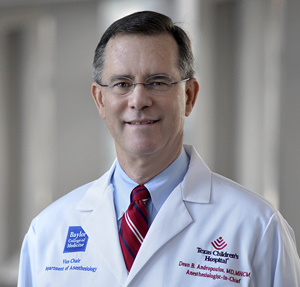Dean Bradley Andropoulos, MD, MHCM
SmartTots Scientific Advisory Board, Member
Dean Bradley Andropoulos, MD, MHCM
Texas Children's Hospital and Baylor College of Medicine
Scientific Profile
Areas of Specialty: Dr. Andropoulos is a board certified anesthesiologist and pediatrician, specializing in the effects of anesthetic and sedative exposure on quantitative brain MRI development and neurodevelopmental outcomes.
Q & A
How can the general public support SmartTots?
Certainly, methods to financially support this important FDA-IARS public-private partnership is a great way for the public to be involved. The public can be informed by being aware of the press, scientific releases, and news stories concerning SmartTots.
International Anesthesia Research Society
Executive Committee, Chair-Elect Board of Trustees, Member
SmartTots
Scientific Advisory Board, Member
Texas Children’s Hospital
Chief, Department of Anesthesiology
Baylor College of Medicine
Professor of Anesthesiology and Pediatrics
Education
Harvard School of Public Health, MS Healthcare Management (2007) University of California, San Diego, MD (1984) University of California, Santa Barbara, BA Biological Sciences (1980)
Training
Professional Affiliations
- American Society of Anesthesiologists
- Society for Pediatric Anesthesia
- International Anesthesia Research Society
- Society for Cardiovascular Anesthesiologists
- Texas Society of Anesthesiologists
- Congenital Cardiac Anesthesia Society
- American Academy of Pediatrics
- Association of University Anesthesiologists
Recent Achievements
- President, Congenital Cardiac Anesthesia Society (2006-2008)
- Board of Directors, Society for Pediatric Anesthesia (2006-2008)
- Chair, Task Force on the Pediatric Anesthesia Fellowship, Pediatric Anesthesia Leadership Group (2010-present)
- Member, Scientific Advisory Board, Association of University Anesthesiologists (2011-present)
Recent Research Funding
-
Neurological Monitoring and Outcomes for Neonates Undergoing Cardiac Surgery with BypassTexas Children’s Hospital Anesthesiology Research Fund (2004-2007)Principal Investigator
-
A Prospective, Randomized, Placebo-Controlled High-Dose Erythropoietin Neuroprotection Trial for Newborns Undergoing Cardiac Surgery with Cardiopulmonary BypassTexas Children’s Hospital Anesthesiology Research Fund (2004-2007)National Institutes of Health (2006-2007)Charles A. Dana Foundation, Brain and Immuno-Imaging Grant (2007-2009)National Institute of Child Health & Human Development (2009-2010)Principal Investigator
Selected Publications
Andropoulos DB, Heard MB, Johnson KL, Clarke JT, Rowe, RW. Post-anesthetic apnea in full-term infants after pyloromyotomy. Anesthesiology 1994 Jan;80(1):216-9.
Andropoulos DB, Rowe RW, Betts J. Anesthetic and surgical airway management during tracheoesophageal fistula repair. Paediatric Anaesthesia 1998;8:313-9. Pressure control ventilation: three anesthesia ventilators compared using an infant lung model.Anesth Analg 2000;91:1145-50.
Rivenes SM, Lewin MB, Stayer SA, Bent ST, Schoenig HM, McKenzie ED, Fraser CD, Andropoulos DB. Cardiovascular effects of sevoflurane, isoflurane, halothane, and fentanyl/midazolam in children with congenital heart disease: an echocardiographic study of myocardial contractility and hemodynamics.Anesthesiology 2001;94:223-9.
Laird TH, Stayer SA, Rivenes SM, Lewin MB, McKenzie ED, Fraser CD, Andropoulos DB. Pulmonary-to-systemic blood flow ratio effects of sevoflurane, isoflurane, halothane, and fentanyl/midazolam in children with congenital heart disease.Anesth Analg 2002;95:1200-6.
Andropoulos DB, Stayer SA, Skjonsby BS, East DL, McKenzie ED, Fraser CD.Anesthetic and perioperative outcome of teenagers and adults with congenital heart disease. J Cardiothorac Vasc Anesth 2002;16:731-6.
Ikemba CM, Stayer SA, Miller-Hance WC, Eidem BW, Su JT, Bezold LI, Hall SR, Havemann L, Andropoulos DB. Myocardial performance index with sevoflurane vs. fentanyl/midazolam in infants with a single functional ventricle.Anesthesiology 2004;101:1298-1305.
Akpek EA, Miller-Hance WC, Stayer SA, Rice CL, East DL, Fraser CD, McKenzie ED, Andropoulos DB. Anesthetic management and outcome of late corrective operations for patients with transposition of the great arteries and a systemic right ventricle. J Cardiothorac Vasc Anes 2005;19:322-28.
Diaz LK, Akpek EA, Dinavahi R, Andropoulos DB. Tracheoesophageal fistula and associated congenital heart disease: implications for anesthetic management and survival. Paediatr Anaesth 2005;15:862-9.
Diaz LK, Andropoulos DB. New developments in pediatric cardiac anesthesia.Anes Clin N Amer 2005;23:655-76.
Vener DF, Tirotta CF, Andropoulos D, Barach P. Anesthetic complications associated with the treatment of patients with congenital cardiac disease: consensus definitions from the Multi-Societal Database Committee for Pediatric and Congenital Heart Disease. Cardiol Young 2008;18(Suppl. 2):271-81.
Vener DF, Jacobs JP, Schindler E. Maruszewski B, Andropoulos D. Databases for assessing the outcomes of the treatment of patients with congenital and pediatric cardiac disease—the perspective of anesthesia. Cardiol Young 2008;18(Suppl. 2):124-9.
Andropoulos DB, Hunter JV, Stayer SA, Nelson DP, Stark AR, Heinle JS, McKenzie ED, Graves DR, Fraser CD. Brain immaturity is associated with brain MRI injury before and after neonatal cardiac surgery with high-flow bypass and cerebral oxygenation monitoring. J Thorac Cardiovasc Surg 2010;139(3):543-56.
Andropoulos DB, Mizrahi E, Hrachovy R, Stayer SA, Stark AR, Heinle JS, McKenzie ED, Dickerson HA, Meador MR, Fraser CD. Electroencephalographic seizures after neonatal cardiac surgery with high flow cardiopulmonary bypass and cerebral oxygenation monitoring. Anesth Analg 2010;110(6):1680-5.
Kaltman JR, Andropoulos DB, Checchia PA, Gaynor JW, Hoffman T, Laussen P, Ohye R, Pearson G, Pigula F, Tweddell J, Wernovsky G, del Nido P, for the Perioperative Working Group. Report of the Pediatric Heart Network and National Heart, Lung, and Blood Institute Working Group on the Perioperative Management of Congenital Heart Disease. Circulation 2010;121:2766-72.
Andropoulos DB, Brady KM, Easley RB, Fraser CD. Neuroprotection in pediatric cardiac surgery: what is on the horizon? Prog Pediatr Cardiol 2010;29:113-122.
